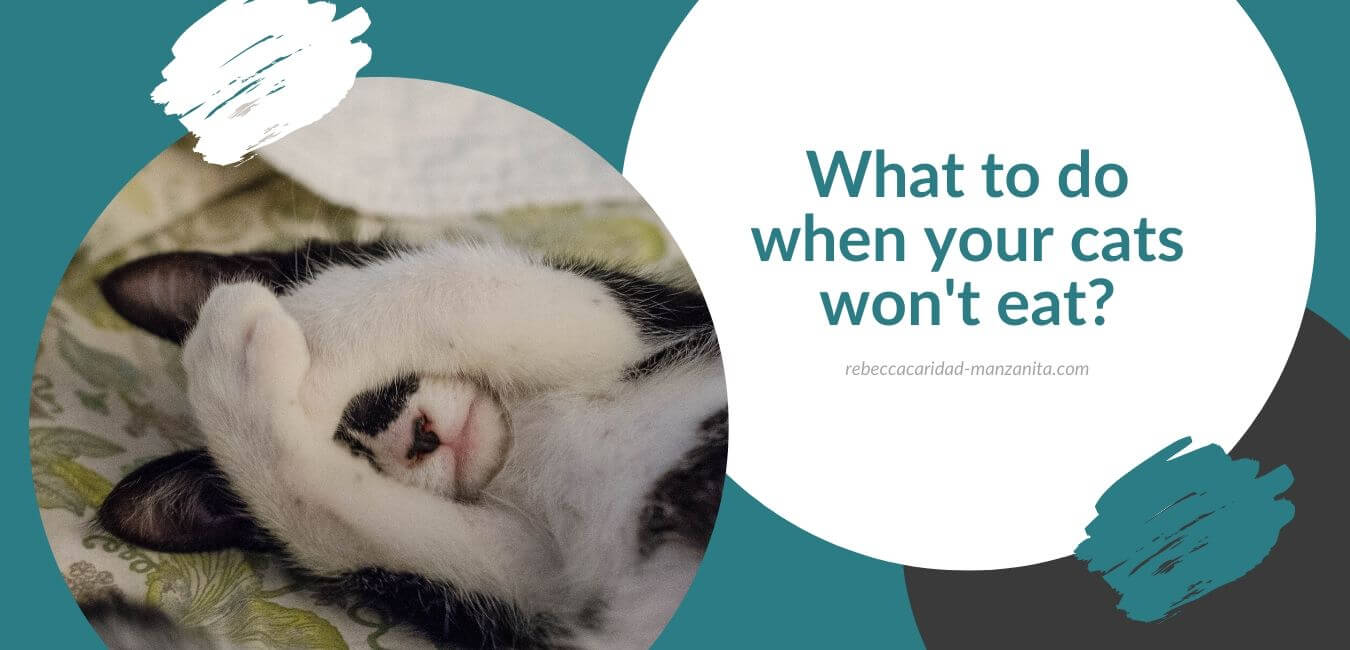When your cats won’t eat – It is so much fun to share food and treats with our kitty and doggy friends. But when they don’t eat, it can be a sign of a serious problem with our friends.
The list of reasons that lead to appetite loss is long and can indicate life-threatening issues. Here are some of the most common concerns.
Don’t hesitate to ask for help if something seems wrong with your four-legged friend who just won’t eat like he or she used to do.
Do evaluate what your pet is eating
Is it a new bag of food? Is it an old bag that has been there a while? Does the food smell good? Is the food based on real meat? Does the food contain corn, by-products, dyes, or sugars? Is there a recall posted on the Internet? All of these questions are important to evaluate and should be asked by your vet.
Things can change from batch to batch in pet food – if it’s a new bag, there may be something disagreeable to taste.
Old food can grow yeast, mold, bugs, or turn rancid. If the food is older than a month, it could have a bad taste. And, it’s a good idea to clean the pet food container in between bags of food, so potential contaminants don’t linger from one bag to the next.
If you think it smells bad, you know your dog or cat thinks it smells bad – their noses are even more sensitive than ours.
Real meat, as the number one ingredient, is one measure of higher-quality food.
Corn, by-products, dyes, and sugars are all indicators of lower quality food. Lower-quality foods can lead to more gastrointestinal upset than higher-end foods. “Meat,” animal digest, feather meal, animal fat, and natural flavors also suggest the food is not the best caliber.
Do look at your pet’s teeth and mouth
Older patients can have rotten teeth, which will interfere with eating. Loose teeth, bad smell in the mouth, tartar covering the teeth, red gums, bleeding gums, and growths are all signs of a serious problem.
On the other hand, young patients can have oral problems too. Retained baby teeth, something stuck between teeth, sores in the mouth or on the lips and gums all need medical help to correct the problem.
Do look to see if any items are missing or partially eaten
Do look if toys, strings, rubber bands, or any foreign object is missing or partially eaten. Particularly our young dogs and cats are at risk of eating things they shouldn’t, but this can occur at any age. Cats tend to eat small things. String, thread, rubber bands, foam, plastic flowers, and the rings from the gallon of milk are just some common things.
Dogs will eat anything! Socks, rocks, rope toys, plastic bags, hair coverings, underwear, unmentionables from the bathroom trash can, bones, dead animals. Anything.
If you suspect anything is missing at all, call your vet as soon as possible. If there is an intestinal foreign body, the sooner you find out, the better your pet’s chance of making it through surgery.
Do consider your pet’s age
Young dogs and cats are at risk of foreign bodies, as just mentioned. Older patients are at risk of metabolic and endocrine problems as well as, unfortunately, cancer.
Young dogs who don’t eat may have parvovirus infection or intestinal worms. Young inappetence cats could have feline leukemia virus, feline immunodeficiency virus, or feline infectious peritonitis. Any of these things can be fatal.
Older cats and dogs who aren’t eating well most commonly have dental disease, kidney disease, liver disease, diabetes, or cancer. Other less common diseases can cause loss of appetite: heart disease, thyroid disease, Cushing’s or Addison’s diseases. A thorough medical evaluation can help track down the problem.
Do call your vet
Vomiting quickly leads to fluid loss and electrolyte imbalance, worsening the underlying problem. Diarrhea, especially bloody, can indicate parvovirus infection, a tear in the intestine, cancerous lumps (polyps), or other scary bacterial infection.
Lethargy (lying around) is a sign something serious is going on, which can be a fever due to a virus all the way to serious infection of one or more body systems. Call your vet immediately if appetite loss is accompanied by vomiting and/or diarrhea or lethargy.
Do not ignore it
Not eating is a serious thing. If your dog or cat doesn’t eat one day, one time – not a big deal. If it’s accompanied by vomiting and/or diarrhea – it could be a big deal. Not eating for two or more days becomes a bigger deal for every day that goes by.
Cats are especially sensitive – a few days without food becomes a medical emergency if they develop fatty liver (hepatic lipidosis). Fatty liver makes a minor few days of not eating turn into a life-threatening liver disease that can cost $100s to $1000s to treat.
Do not force your pet to eat without seeking medical help
If your pet has an obstruction, force-feeding will make it worse. Pets who have been vomiting may continue to vomit if they are force-fed. This worsens the cycle of vomiting and dehydration – which can lead to death.
Do not feed over the counter medications for humans
Humans and our four-legged friends don’t metabolize medications the same way. Things that are safe for people are not necessarily safe for cats or dogs. Anything containing pain-relievers can be fatal, especially to cats.
Summary
One of our favorite things to do is feed our four-legged friends. When our friends don’t eat, we wonder – for good reason. As the list of reasons not to eat is long and potentially scary, call your vet when any warning sign goes up.

